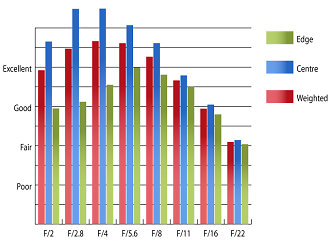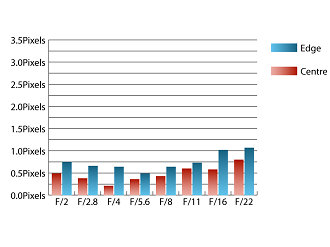Samyang 12mm f/2.0 NCS CS MFT Lens Review
Samyang 12mm f/2.0 NCS CS Performance
Sharpness is already outstanding in the centre of the frame from maximum aperture, and clarity towards the edges falls a shade short of good levels. Stopping down improves sharpness across the frame, with peak sharpness being reached in the centre between f/2.8 and f/4, with clarity towards the edges catching up to excellent levels at f/5.6.
How to read our charts
The blue column represents readings from the centre of the picture frame at the various apertures and the green is from the edges. Averaging them out gives the red weighted column.The scale on the left side is an indication of actual image resolution. The taller the column, the better the lens performance. Simple.
For this review, the lens was tested on a Panasonic Lumix GX7 using Imatest.
For a fast, wide-angle lens, chromatic aberrations are very well controlled. Fringing barely exceeds one pixel width, and only does when stopped down to f/16 or beyond. This low level of fringing should pose few issues, even in large prints and harsh crops from the edges of the frame.
How to read our charts
Chromatic aberration is the lens' inability to focus on the sensor or film all colours of visible light at the same point. Severe chromatic aberration gives a noticeable fringing or a halo effect around sharp edges within the picture. It can be cured in software.Apochromatic lenses have special lens elements (aspheric, extra-low dispersion etc) to minimize the problem, hence they usually cost more.
For this review, the lens was tested on a Panasonic Lumix GX7 using Imatest.
Distortion is fairly typical for a fast aperture wide angle prime lens, with 1.2% barrel distortion present, which is only a mild amount, but it still may become noticeable, especially in images with straight lines parallel to the image edges.
Falloff of illumination towards the corners is reasonable for a lens with a fast f/2 maximum aperture. At f/2 the corners are 1.64stops darker than the image centre and visually uniform illumination is achieved with the lens stopped down to f/4 or beyond.
A little contrast is lost when shooting into the light at maximum aperture, but on the whole control of flare is good with this lens. A petal shaped hood is supplied with the lens, which does a good job of shading the lens from extraneous light that may cause issues.
Value For Money
Priced at around £330, this lens is very reasonably priced for a wide angle with a fast f/2 maximum aperture.
The closest equivalent in Micro Four Thirds fit is the Olympus 12mm f/2 lens, which costs around £500. This lens does sport autofocus though, so may be worth the extra £170 to some.
Add your message
Please login here or if you've not registered, you can register here. Registering is safe, quick and free.
photodo Stats
428 MTF tests
74 in-depth photodo reviews
100+ users join each day
Help the lens community by reviewing or rating a lens today via our lens search
Latest Lens Reviews
- Chinon 28mm f/2.8 Vintage Lens Review
- Canon EF 70-200mm f/4L IS II USM Lens Review
- Samyang AF 85mm f/1.4 EF Review
- Sigma 70mm f/2.8 DG Macro Art Review
- Samyang AF 24mm f/2.8 FE Review
- Meike 50mm f/1.7 Review
- Tamron 70-210mm f/4 Di VC USD Review
- Lensbaby Burnside 35mm f/2.8 Review
- Asahi Super Takumar 50mm f/1.4 Review
- Asahi Super-Multi-Coated Takumar 135mm f/3.5 Review


